Story by: David Riley
A Rochester resident and a former journalist, David is completing a master’s degree in urban planning at the University at Buffalo…
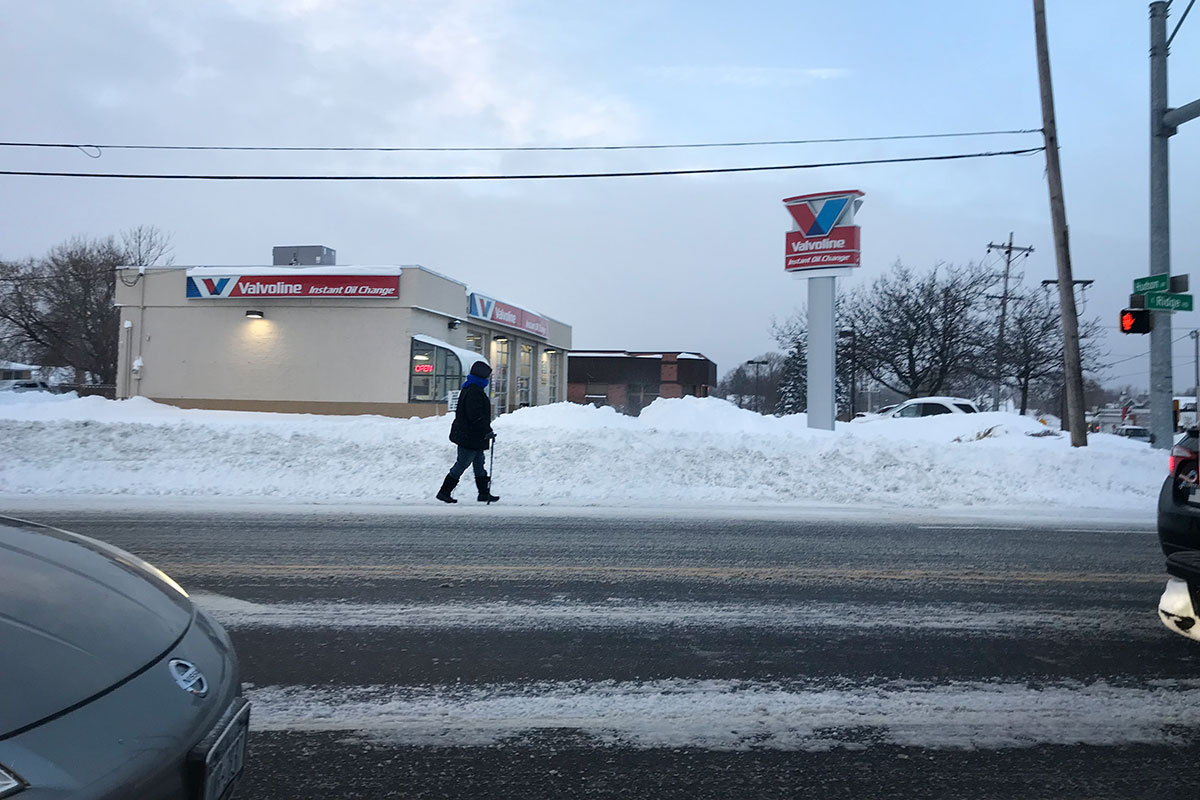
For tens of thousands of Monroe County residents, a sidewalk isn’t just a convenience. It’s a vital connection to the world.
Nearly 12,000 people here walk to their jobs, U.S. Census data shows. Another 13,000 walk to and from bus stops in order to take public transportation to work, including as many as 1 in 3 workers in some city neighborhoods. Many people also rely on sidewalks to get to and from school, medical appointments or grocery stores, much less to go for a jog or walk the dog.
So for many people, it isn’t simply an annoyance if part of a sidewalk turns into a snowdrift during the winter. It’s a disruption that forces people going about daily routines to wade through snow or take a dangerous chance and walk in the street. For people with disabilities, a snowy sidewalk can make a usually simple outing impossible.
Yet keeping sidewalks clear is not always a priority for municipalities in the Northeast and Midwest. The City of Rochester does more than many other Snow Belt cities. While property owners here are responsible for clearing adjacent sidewalks of snow and ice, the city also provides supplemental sidewalk plowing anytime it snows at least 4 inches. The program has drawn some interest in recent years from Buffalo and Syracuse, neither of which generally plow sidewalks beyond public buildings. A handful of local suburbs also provide some municipal sidewalk plowing, including Greece and Irondequoit.
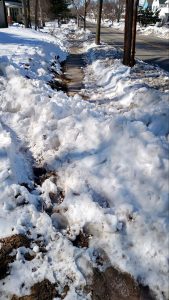 Even so, traversing sidewalks here can be difficult, and the early March snowstorm was a reminder of this. In the city, neighborhoods can still turn into a house-by-house patchwork of bare pavement and packed snow, depending on whether property owners are able or willing to shovel. Bus stops, curb cuts and crosswalks – all integral parts of pedestrian infrastructure – sometimes aren’t cleared. And in some cases, plow contractors who clear driveways and parking lots leave snow piled on adjacent sidewalks.
Even so, traversing sidewalks here can be difficult, and the early March snowstorm was a reminder of this. In the city, neighborhoods can still turn into a house-by-house patchwork of bare pavement and packed snow, depending on whether property owners are able or willing to shovel. Bus stops, curb cuts and crosswalks – all integral parts of pedestrian infrastructure – sometimes aren’t cleared. And in some cases, plow contractors who clear driveways and parking lots leave snow piled on adjacent sidewalks.
This leaves local pedestrians and transit users asking: Sure, we might have it better than Buffalo and Syracuse, but can’t we do better?
Most everyone agrees there is room to make our communities more walkable in the winter.
“We believe in continuous improvement,” said Norman Jones, the city’s commissioner of environmental services, during an interview in February. “We don’t rest. We have to get better.”
How to do so is a matter of both funding and philosophy on where a property owner’s civic duty ends and a shared community responsibility begins. For some, this is also a question of equity – whether pedestrian infrastructure should be cleared as thoroughly as roads for drivers. This piece is meant to contribute to that discussion by clarifying how municipalities in the area deal with sidewalks in the winter now; revisiting what’s changed since a 2015 push for city property owners to keep up with shoveling; and exploring what options we may be able to consider from other wintry cities.
There may be renewed urgency to this conversation after the March 2 death of a 62-year-old woman in a hit-and-run on Clifford Avenue. While the circumstances are not entirely clear, the family of the victim, Nilsa Rivera, has said they believe she was walking in the street because the sidewalks were not clear.
Who’s responsible?
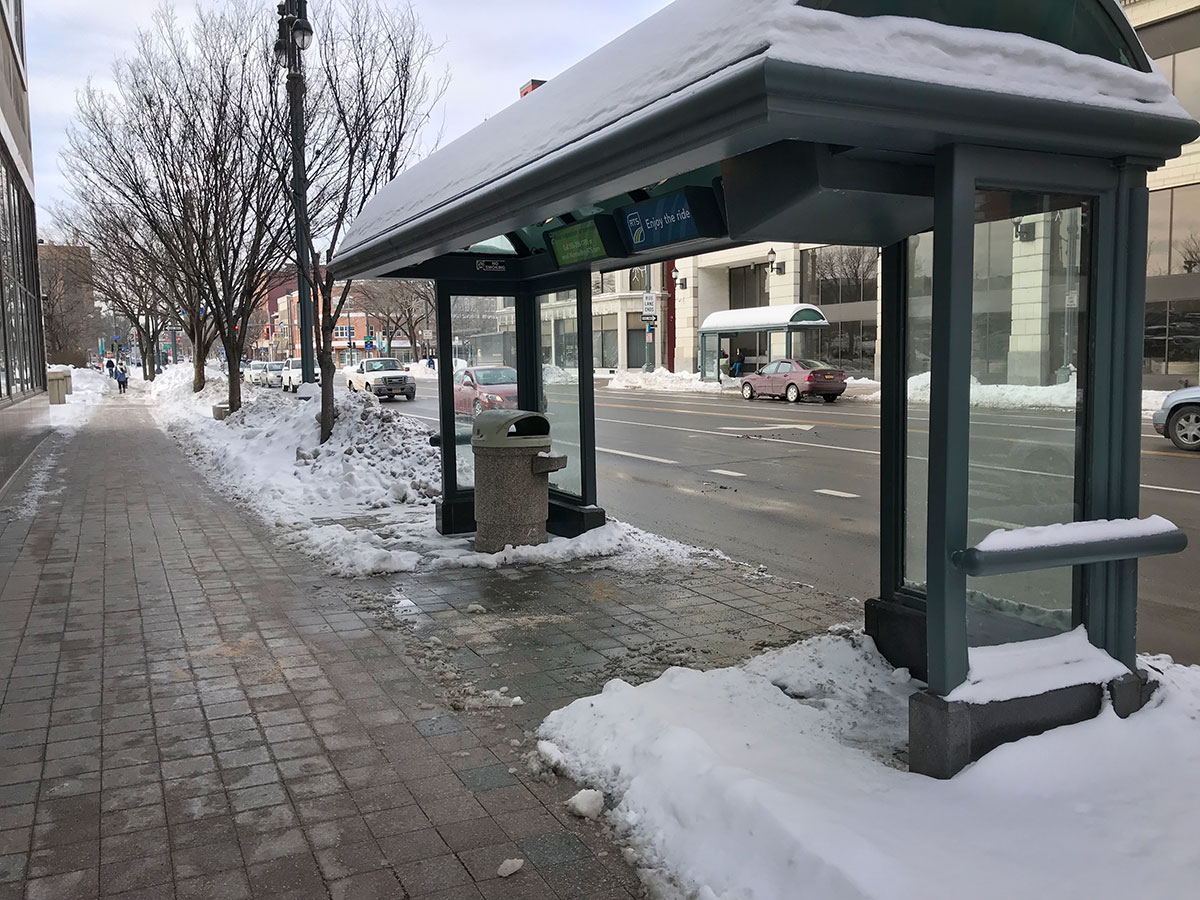 The city’s sidewalk plowing program costs a little more than $1 million a year and is funded through a fee of about $35 on the annual property tax bill for an average home. Property owners within a downtown enhancement district – an area bounded roughly by Plymouth Avenue and Church, Chestnut and Broad Streets – pay an additional fee for enhanced sidewalk snow removal.
The city’s sidewalk plowing program costs a little more than $1 million a year and is funded through a fee of about $35 on the annual property tax bill for an average home. Property owners within a downtown enhancement district – an area bounded roughly by Plymouth Avenue and Church, Chestnut and Broad Streets – pay an additional fee for enhanced sidewalk snow removal.
The city hires a fleet of private contractors who fan out after storms to plow more than 850 miles of public sidewalks. But City Code § 104-11 makes clear that property owners are ultimately responsible to keep their sidewalks free of snow and ice. The city’s website also stresses that sidewalk plowing is “supplemental.”
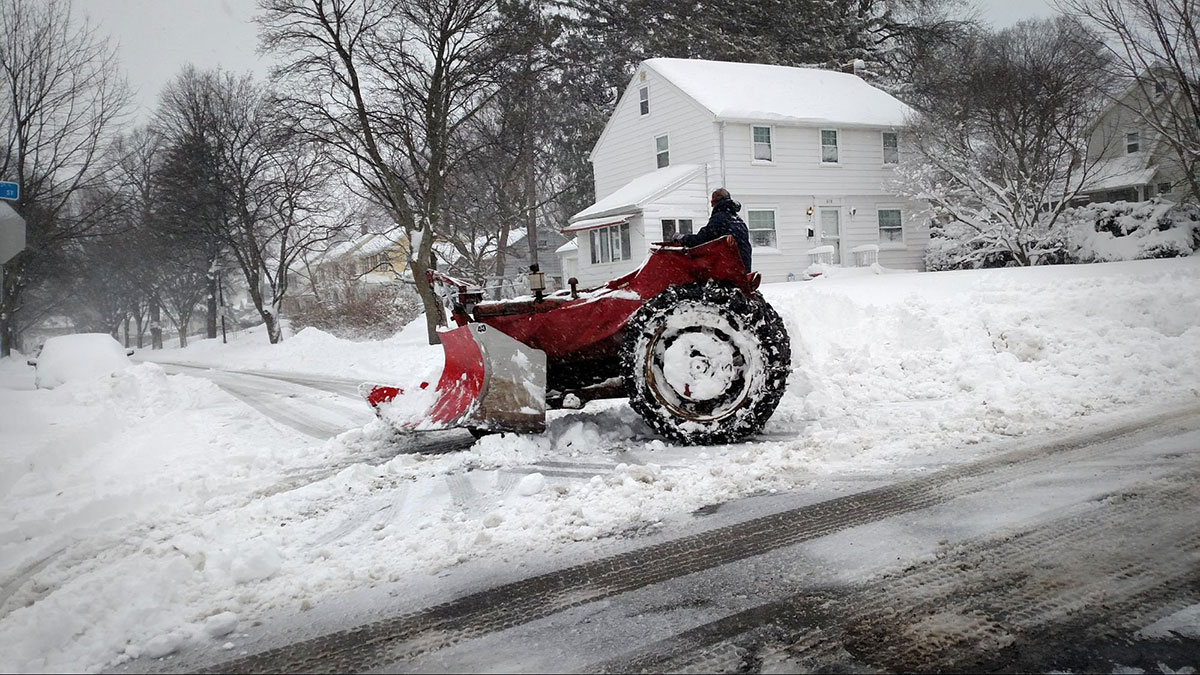 Many contractors use what Jones described as grove tractors, designed for navigating the narrow spaces between rows of trees in orchards. Per the city’s expectations, these tractors are usually fitted with V-shaped plow blades the width of a typical sidewalk.
Many contractors use what Jones described as grove tractors, designed for navigating the narrow spaces between rows of trees in orchards. Per the city’s expectations, these tractors are usually fitted with V-shaped plow blades the width of a typical sidewalk.
Even for an unbuilt lot, an owner is supposed to keep the sidewalk clear, per the code. And after the sidewalk plows come out, “it shall be the duty of the owner to remove the snow and ice remaining after such plows have gone through.” The code goes on to prohibit moving snow from your property onto a sidewalk, a fire hydrant, a bus stop or the street. Snow that falls after 8 p.m. is supposed to be removed by 9 a.m., or vice versa if it snows during the day.
The city has taken a light touch with enforcement, however, without generally imposing fines against property owners who fail to maintain their sidewalks. The city would potentially be fining homeowners who can’t afford to pay, Jones said. Instead, Mayor Lovely Warren’s administration has focused on trying to educate the public about the rules.
“If we can get compliance through education, it might be a little more difficult, but it will have a more lasting effect,” Jones said.
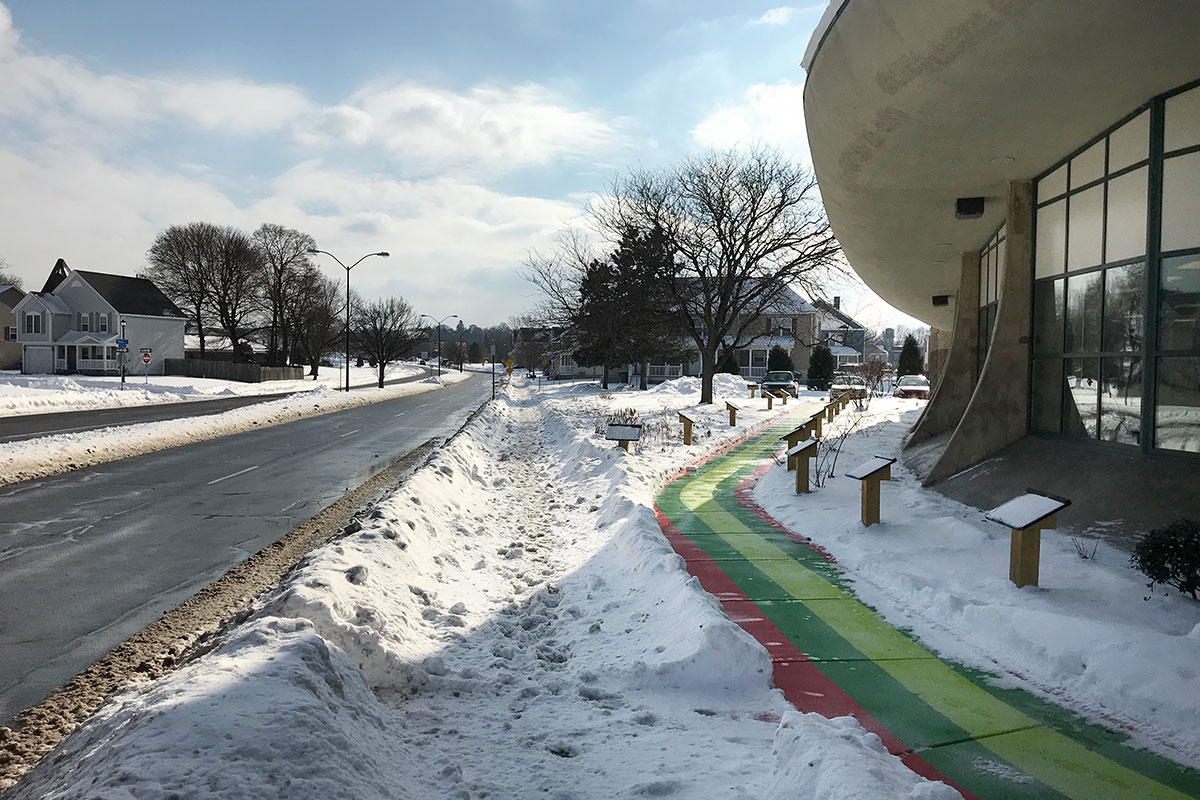
Meanwhile, rules for sidewalk clearing vary in the suburbs bordering the city.
Greece and Irondequoit, both of which have hundreds of miles of sidewalks, plow walkways on both sides of major roads and near schools, but on only one side of residential streets, alternating each year.
In Irondequoit, the town focuses on routes to and from West Irondequoit’s neighborhood schools, where students typically walk, according to Robert Kiley, the town’s public works commissioner and highway superintendent. While Irondequoit’s code also says property owners are responsible for clearing sidewalks, the expectation is not enforced, Kiley said. Greece has no such expectation of residents, according to Kirk Morris, the town’s public works commissioner.
In Brighton, the town has typically provided sidewalk plowing on major roads, but not in residential neighborhoods. Residents have the option of forming snow removal districts in which they pay the town an annual fee to plow their sidewalks for them. Penfield provides sidewalk plowing, while Gates has no sidewalk snow removal program.
While enforced unevenly, federal law is part of this conversation, too. The U.S. Americans with Disabilities Act (ADA) requires public agencies to maintain walkways in accessible condition, with “only isolated or temporary interruptions.” That timeframe is not clearly defined, but it includes “reasonable snow removal efforts,” according to a federal guide to the ADA. If a community delegates this responsibility to property owners, this approach requires “additional education, inspection, enforcement and administrative actions to be successful,” according to another federal website. Enforcement, however, is rare.
Robin Paul Malloy, a Syracuse University professor, co-authored a paper last year arguing that sidewalk clearance is clearly required by the ADA, “not to mention an appropriate way of making our communities more accessible to people with disabilities and to people seeking to age in place.”
A push for property owners to step up.
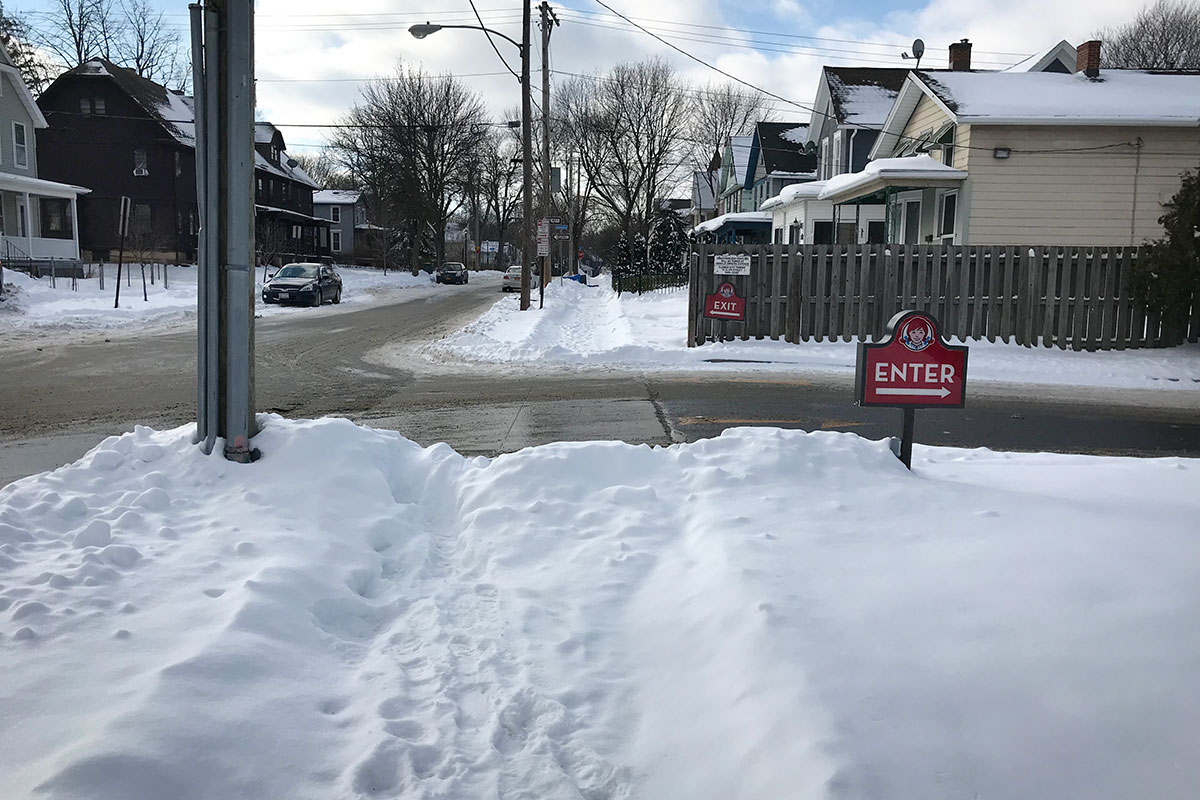 At Warren’s request, City Council voted to amend the City Code in 2015 to clarify that property owners alone are responsible for keeping sidewalks clear. Earlier language said this was a duty for either owners or first-floor tenants, which sometimes led to confusion, Jones said.
At Warren’s request, City Council voted to amend the City Code in 2015 to clarify that property owners alone are responsible for keeping sidewalks clear. Earlier language said this was a duty for either owners or first-floor tenants, which sometimes led to confusion, Jones said.
Another piece of legislation would have increased fines that could be imposed against property owners who fail to clear sidewalks, but this proposal did not come to a vote.
The code change was part of a larger push by the city in late 2015 for property owners to do their part to keep sidewalks open. This included a public service campaign with a rhyming slogan: “Clear the snow so all can go.” The campaign was a partnership with the Center for Disability Rights (CDR), which had been in discussions that year with the city about problems with inaccessible sidewalks in the winter. The campaign emphasized shoveling and snowblowing as a civic responsibility for property owners.
 Jones said city staff also met with neighborhood groups across Rochester at the time to get the message out, and did so again last fall.
Jones said city staff also met with neighborhood groups across Rochester at the time to get the message out, and did so again last fall.
There is no definitive way to measure what impact the campaign had. Stephanie Woodward, director of advocacy at CDR, said recently that the city has been responsive to the concerns CDR raised in 2015. City staff have since contacted Woodward after storms to discuss which apartment complexes have large populations of people with disabilities, and city crews focus on clearing those sidewalks early.
Woodward also receives sidewalk complaints and relays them to the city (though she encourages people to call 311 instead). In such cases, city code enforcement staff may examine the sidewalk and speak with the appropriate property owner, Jones said.
“While we’re not where we should be,” Woodward said, “we’re leading the way.”
Jones also believes things are getting better. “It’s anecdotal, but you see it,” he said. “You see swatches of compliance that you didn’t see before.” Since 2015, the city also has begun plowing sidewalks on a handful of state-owned bridges – including the Veterans Memorial Bridge on State Route 104 and the O’Rorke Bridge in Charlotte – which otherwise would go unplowed, according to Jones. The city also has contracted a handful of organizations, such as North East Area Development, to have participants in a job training program help to clear sidewalks in a few neighborhoods.
Irondequoit, meanwhile, has been working to improve its sidewalk plowing operation in recent years. Kiley said the town has upgraded its equipment for sidewalk plowing and added routes in recognition of the growing importance of keeping walkways clear.
“More and more folks are focusing on being more active getting around, rather than driving everywhere,” he said.
Where to go from here?
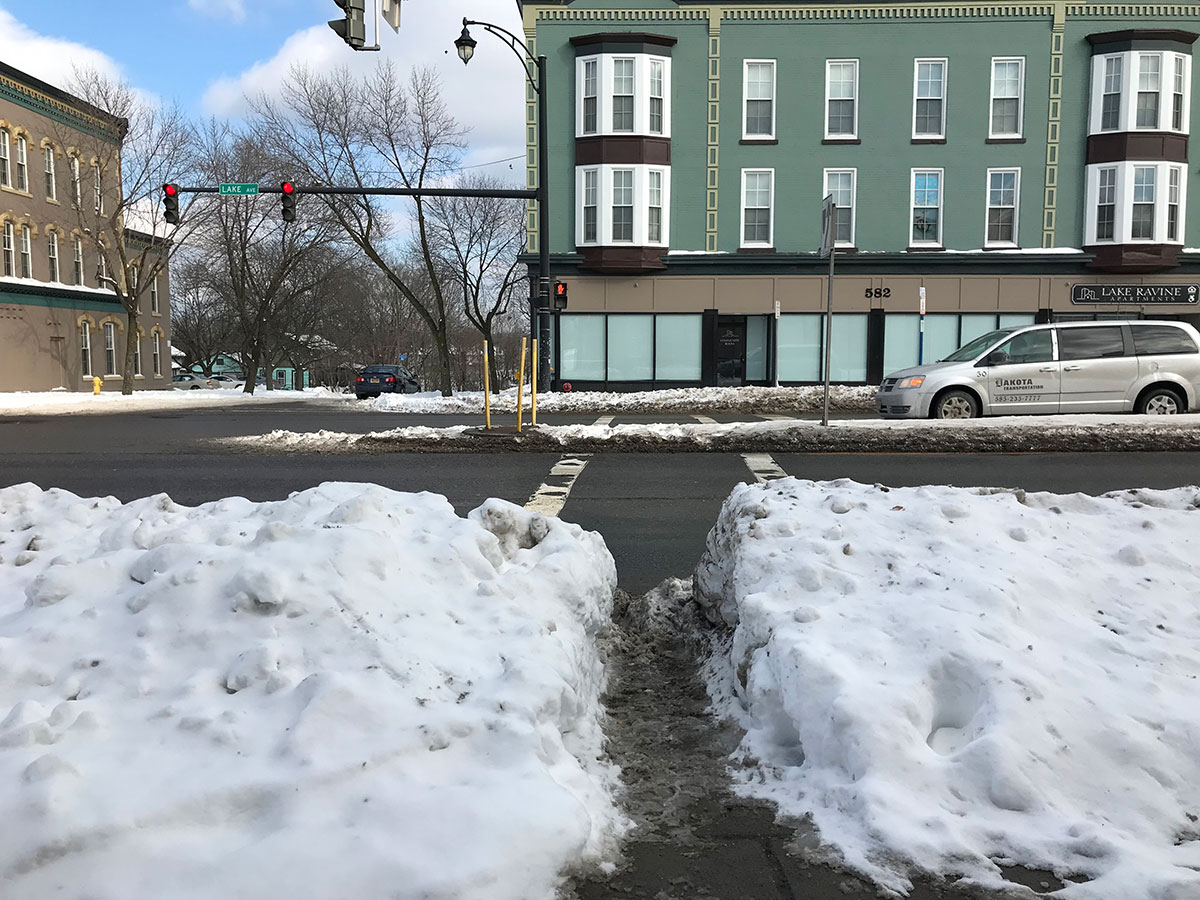 By just about any account, there’s more work to do.
By just about any account, there’s more work to do.
Jones doesn’t envision a more extensive citywide sidewalk plowing operation anytime soon. For one thing, it would come at additional cost, and that would most likely have to come from an increase in the embellishment fee that property owners already pay for supplemental plowing, he said. More plowing would also would cause more issues with damage to lawns, he said.
Jones said he would especially like to see neighbors work together to make sure sidewalks get cleared properly. To him, it’s a matter of civic responsibility.
But the city has looked at other options, too. This winter, the city issued warnings – but not fines – to plow contractors who pile snow in the street or on sidewalks while clearing their customers’ driveways or parking lots. Jones expressed interest in submitting a proposal to also issue warnings in the future to property owners who fail to clear their sidewalks.
“Eventually, I would want to put together a plan, with the approval of the administration, to start giving out warnings to people who are not doing what they’re supposed to be doing,” Jones said.
In Irondequoit, Kiley said he’s also had initial discussions with other town highway officials about the potential for suburbs to begin imposing fines against plow contractors who dump snow in the street or on sidewalks. The problem creates a hardship for pedestrians, he said.
Woodward highlighted other challenges that remain: uncleared bus stops and curb cuts, both of which can make it impossible for people with disabilities to get around. This can leave people with no way to board a bus or cross a street without surmounting a sizeable mound of snow and ice.
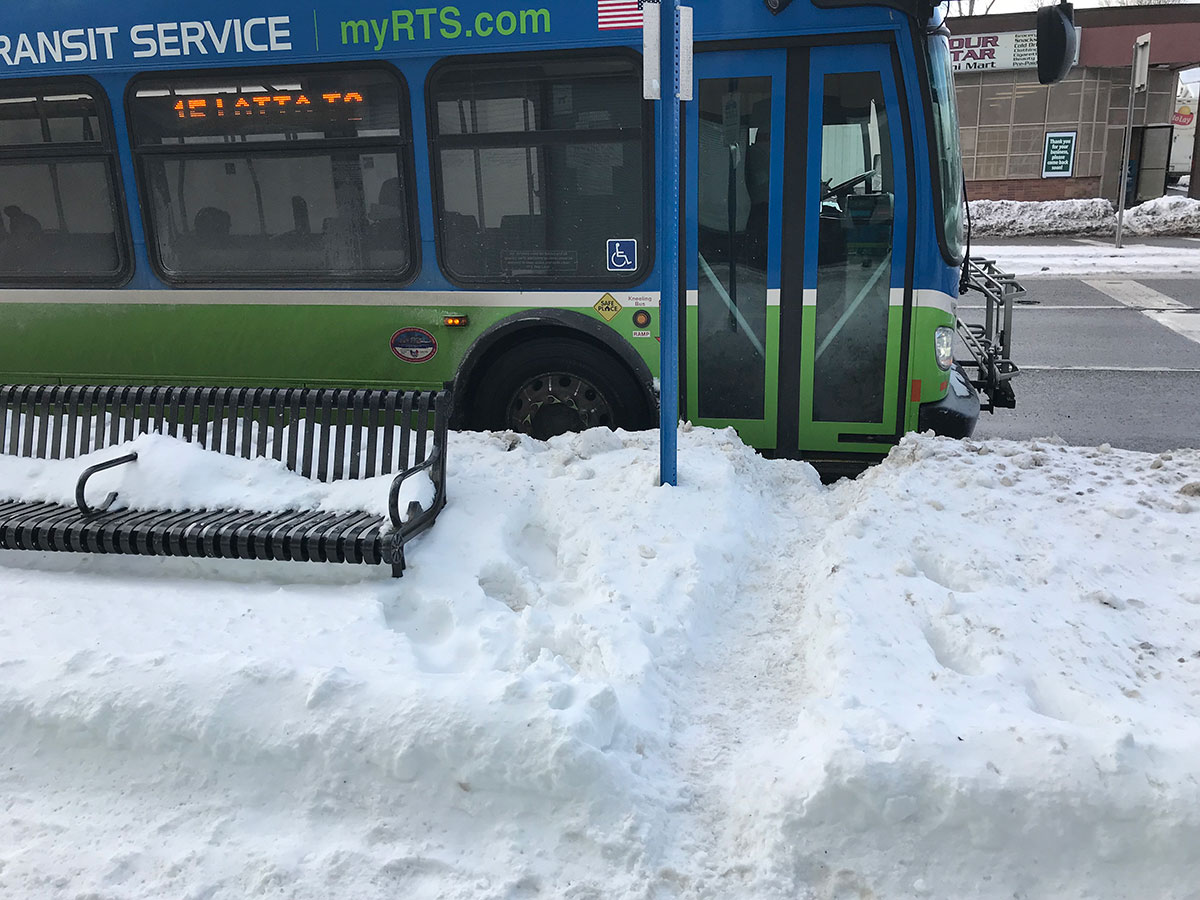 The city helps to clear bus shelters, but it is not responsible for individual stops, Jones said. Woodward would like to see property owners clear bus stops as well. Legal Assistance of Western New York, Inc. recently conducted an analysis for Reconnect Rochester and found that if property owners are expected to clear bus shelters and stops of snow and ice, the city code does not make that explicitly clear.
The city helps to clear bus shelters, but it is not responsible for individual stops, Jones said. Woodward would like to see property owners clear bus stops as well. Legal Assistance of Western New York, Inc. recently conducted an analysis for Reconnect Rochester and found that if property owners are expected to clear bus shelters and stops of snow and ice, the city code does not make that explicitly clear.
In Greece, Supervisor Bill Reilich has directed public works crews to clear snow from some bus shelters on a more regular basis, according to Morris.
“Some shelters are on busy main roads and he was concerned about safety and riders possibly having to stand in the road if the shelters were filled in,” Morris said. “We worked with RTS to identify their shelters that typically fill in with snow and we now clear those for our residents and visitors.”
Snow removal beyond Rochester.
![Snowy sidewalk. Albany, NY. [FLICKR PHOTO: rik-shaw (look 4 light)]](https://reconnectrochester.org/wp-content/uploads/2018/03/albany-sidewalk-snow-removal.jpg) Rochester is far from unique among Snow Belt cities in its approach to snow and sidewalks, and placing responsibility on property owners. But some cities in the Northeast and Midwest and our neighbors to the north do a few things differently.
Rochester is far from unique among Snow Belt cities in its approach to snow and sidewalks, and placing responsibility on property owners. But some cities in the Northeast and Midwest and our neighbors to the north do a few things differently.
Montreal, a much larger city of about 1.7 million, is perhaps the gold standard in snow removal. The city not only plows sidewalks, but trucks snow away to get rid of the piles that often obstruct walkways and crosswalks in U.S. cities. This comes at a significant cost, though – about $126 million this year, in U.S. currency – and while Montrealers might be spoiled by our standards, they aren’t always pleased with the results either, judging by news coverage of complaints after a January snowstorm there.
In terms of enforcement, some U.S. cities are simply more aggressive about fines. In New York City, the city Sanitation Department hands out fines ranging from $100-$350, depending on whether it’s a first, second or third offense.
Minneapolis, Minn., Madison, Wisc., and Baltimore County, Md., among other communities, have ordinances that allow municipal crews to clear sidewalks if property owners have ignored warnings to do so. These cities can then bill the owner or add a fee or lien to his or her next tax bill to recoup the cost. Madison, in particular, focuses stricter enforcement on major pedestrian corridors.
Closer to home, the City of Albany appears to have similar rules, but they reportedly were not enforced until recently. It’s worth noting that in Minneapolis, it can still take 5 to 7 days to clear sidewalks, and there is evidence that fines are unevenly applied when they’re issued. This approach also doesn’t address concerns about fining low-income residents.
Other cities have focused on encouraging property owners to shovel. Chicago launched an “Adopt-A-Sidewalk” program in 2012 and provides neighborhood groups with door hangers meant to remind property owners of their responsibilities to shovel. A volunteer “Snow Corps” (an idea that may sound familiar to Reconnect Rochester members) also helps to clear sidewalks where seniors, people with disabilities and others might have difficulty shoveling. In Madison, the city provides free sand to homeowners to help provide some traction on sidewalks.
Still other cities have tried a more grassroots approach. The Water Hill neighborhood in Ann Arbor, Mich., has drawn interest for its Snow Buddy program. Neighbors pooled resources to buy a tractor equipped with a plow and liability insurance, and a crew of volunteers work together to plow sidewalks after storms. “I came gradually to understand that a system that assigns sidewalk maintenance to every homeowner will never function well for the pedestrian,” lead organizer Paul Tinkerhess told CityLab in 2015. “Eight out of 10 walkways might be cleared, but there is always going to be someone who is sick or out of town or just hasn’t gotten around to it yet.”
Something like this could be feasible in Rochester, in theory, if residents petitioned for a local improvement ordinance to pay for enhanced snow removal. Jones notes that this would require ongoing, long-term management. It’s also an option limited to neighborhoods that have resources to pool.
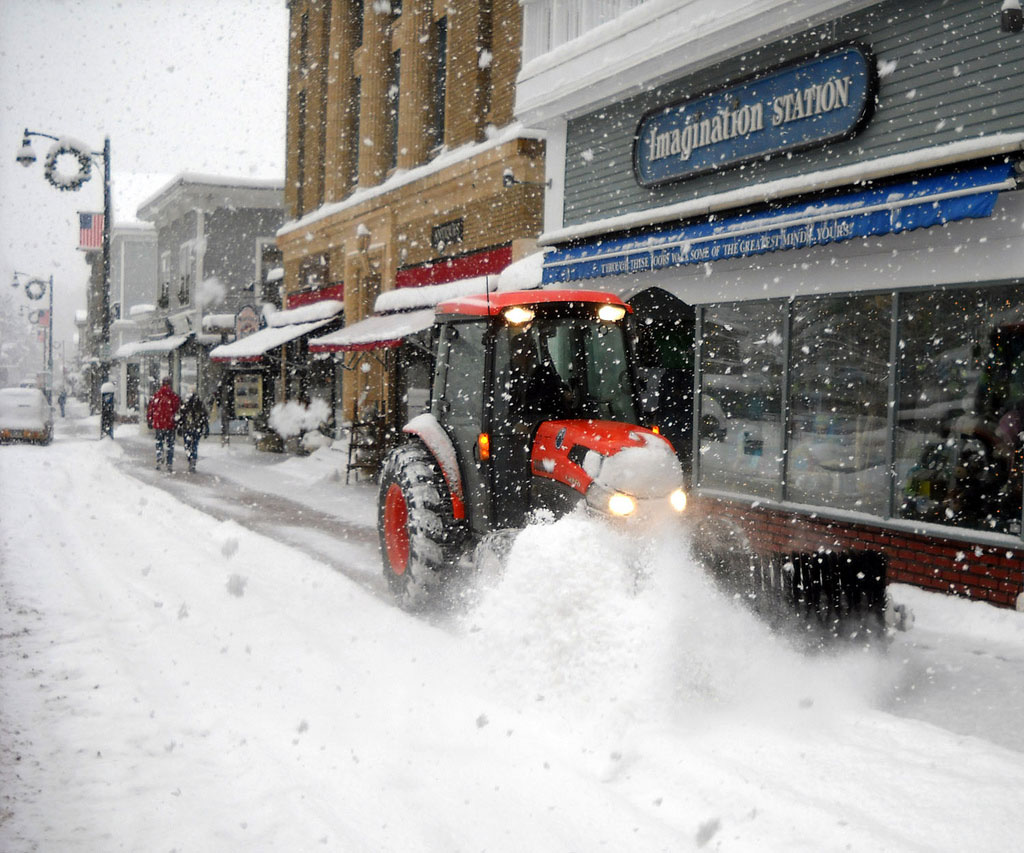 Finally, there may be technical solutions that make sidewalk clearing more effective. Jones said the City of Rochester plans to experiment with using machines equipped with rotating brushes to clear cycle tracks in the city, which are made with permeable pavement that would be damaged by traditional plows. Similar devices are sometimes used elsewhere to clear sidewalks or paved paths.
Finally, there may be technical solutions that make sidewalk clearing more effective. Jones said the City of Rochester plans to experiment with using machines equipped with rotating brushes to clear cycle tracks in the city, which are made with permeable pavement that would be damaged by traditional plows. Similar devices are sometimes used elsewhere to clear sidewalks or paved paths.
Both Jones and Woodward separately described what they think is needed to make the biggest difference: A culture change, in which property owners recognize the importance of clearing sidewalks, and support one another in getting the job done.
“When we know we’re getting a major event and you need some help, that’s what we’re doing,” Jones said of the existing sidewalk plowing program. “We’re providing some additional help to you.”


One thing I’d like to see is a page on the city’s website where we can report trouble spots. I think they already have one for potholes and it seems pretty effective, could it be adopted to allow for snow complaints as well?
Maybe it’s laziness, but I don’t want to have to bother 311 calling about snow piles over the sidewalk. But if I could report it easily, I’d write up the business at the end of my street that dumps their parking lot snow across the sidewalk every single time it snowed. It’s annoying and illegal.
I agree Ben. Its a nuisance having to complain about irresponsible people and their snow piles. If there was a way to report it easily then that would be very effective.
This article shares a lot of light with the struggles every state, city and snow removal companies are currently experiencing right now. I recently started my own snow removal company and I can tell you that it might seem an easy task removing snow but there’s a lot to take into consideration. Each company take care of the snow removal differently and and this also differs state to state. Choosing a place to dump the snow its really important so that this does not cause a concern or a nuisance to the public. This is something business owners should discuss with snow removal companies. Thanks